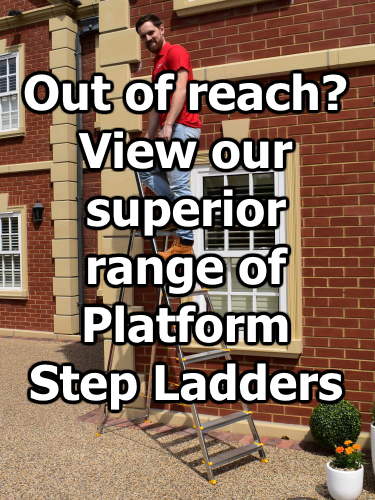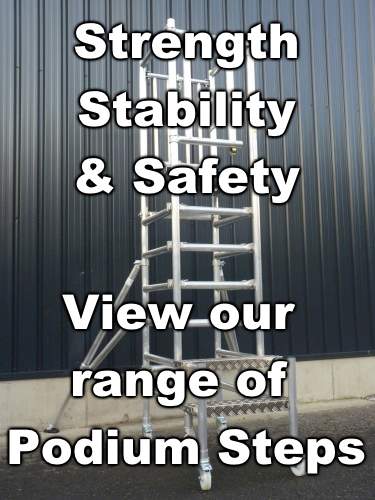Standards and Regulations for Ladders and Scaffold Towers
A third of all reported fall-from-height incidents involve ladders and step ladders - on average this accounts for 14 deaths and 1200 major injuries to workers each year. Many of these injuries are caused by inappropriate or incorrect use of equipment. As a result of this The Health & Safety Executive (HSE) has provided information to prevent falls from height detailed in the Working At Height Regulations 2006 - a brief outline follows:
According to the HSE, common factors resulting in falls from height include:- Failure to provide safe systems of work.
- Failure to ensure that safe systems of work are followed.
- Inadequate information, instruction, training or supervision provided.
- Failure to use and provide appropriate and safe plant/equipment.
- Failure to provide safe plant/equipment.
The HSE's key messages on preventing falls from height are: - Follow good practice for work at height.
- Follow your risk assessment, plan and organise your work properly and make sure everyone involved is competent to their level or responsibility.
- Try to avoid the need for work at height where you can. Where you can't, take steps to prevent falls, where you cannot prevent a fall then you must mitigate the risk of injury should a fall occur.
- Always select collective measures to prevent falls (such as guardrails and working platforms) before other measures which may only mitigate the distance and consequences of a fall or which may only provide personal protection from a fall.
The HSE has determined a simple hierarchy for managing and selecting equipment for work at height. In this, duty holders must: - avoid work at height where they can.
- use work equipment or other measures to prevent falls where they cannot avoid working at height.
- where they cannot eliminate the risk of a fall, use work equipment or other measures to minimise the distance and consequences of a fall should one occur.
- All work at height is properly planned and organised.
- those involved in work at height are competent.
- the risks from work at height are assessed and appropriate work equipment is selected and used.
- the risks from fragile surfaces are properly controlled.
- equipment for work at height is properly inspected and maintained.
There are various standards and kitemarks that relate to access equipment (ladders, loft ladders & scaffold towers). Below we provide a brief outline of the current standards. Comprehensive information regarding the latest standards and more detailed information can be found by contacting the British Standards Institute, PASMA or the Health & Safety Executive.
Kitemarks & Standards for Ladders & Step Ladders Please note any standard is only the minimum standard - as such many ladders just are manufactured to scrape through testing to meet the approved standard whilst other ladders far exceed its published standard. At BPS we ensure all of our ladders exceed the published standard and are scrupulous in choosing our suppliers and products. All of our ladders are manufactured to a standard which exceeds the requirements of the relative classifications - beware others are not.
The UK has three categories for ladder & step ladder strength:
| Kitemark | Standard | Maximum Static Vertical Load/Duty Rating | Details |
| BS 2037 Class 1 | Industrial | Max Static Vertical Load - 175kg (27.5 stone). Duty Rating - 130kg (20.5 stone) | These are the strongest types of ladder that you can buy. Industrial ladders are designed to be used on building sites for long periods of time and to withstand almost constant use. |
| EN131 (Formally known as BS2037 Class 2) | Trade | Max Static Vertical Load - 150kg (23.5 stone). Duty Rating - 115kg (18 stone) | EN131 is the new UK trade standard replacing the old Class 2 standard. This is the most common ladder standard in the UK and will guarantee that the product you buy have been fully tested for trade and domestic use. |
| BS 2037 Class 3 | Domestic | Max Static Vertical Load - 125kg (19.5 stone). Duty Rating - 95kg (15 stone) | This is the lightest standard in the UK and is designed for occasional use around the house. These ladders are not designed to be used by tradesmen or on building sites; in fact using them will contravene Health & Safety regulations. As such BPS does not sell this type of ladder. |
Certain ladders are not covered by any standard - these include Conservatory Ladders or Roof Ladders for example - we ensure these always comply with the relevant standard (they are made from trade or industrial materials) but they are not kitemarked because no kitemark will apply to the product.
Kitemarks & Standards for Loft Ladders There is now a standard class for all loft ladders sold in the UK and Europe.
- EN14975 - Max safe working load 150kg (23.5 stone)
This standard applies to both timber and metal loft ladders.
Kitemarks & Standards For Mobile Scaffold Towers The standard for scaffold towers in the UK is BS EN1004. This standard is the same in Europe where it is called EN1004. This standard applies to trade and industrial strength towers.
Both BS EN1004 & WAHR require mobile scaffold towers to have:
- Stabilisers or outriggers fitted where necessary to guard against overturning.
- Ladder access to the platform (either vertical ladders or inclined).
- Trapdoor platforms for safe access from the ladder to the platform.
- Toeboards fitted around the working platform.
The WAHR also stipulate the erection and dismantling method known as 'Through The Trapdoor' (or 3T for short) which is universally regarded as the best practice in the industry. The Health & Safety Executive has required all users to add extra equipment to BS EN1004 towers to also meet this building specification. 'Through The Trapdoor' ensures that no one has to stand on a platform without handrail protection. All BPS towers meet this building method to satisfy the needs of the HSE - customers should always check this if they are looking elsewhere.
For Comprehensive details regarding Working At Height, please visit: http://www.opsi.gov.uk/si/si2005/20050735 and
http://www.opsi.gov.uk/si/si2007/uksi_20070114_en_1 To ensure you are meeting all of the above criteria contact BPS for advice on the best product to suit your needs.










